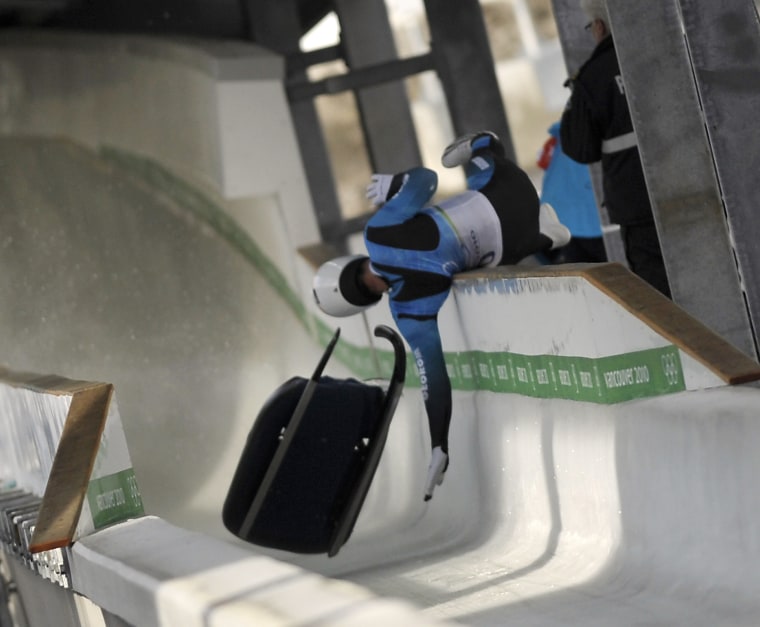A luge athlete from the country of Georgia died after a horrific accident during a training run, hours before the Opening Ceremony of the Winter Olympics took place Friday night. Nodar Kumaritashvili, 21, lost control of his sled and then flew over the side of the track before crashing headfirst into a metal pole.
Kumaritashvili received CPR by medics who were quickly on the scene at the Whistler Sliding Centre and was airlifted to a local hospital, but he could not be revived. He was not considered a top competitor here, but his shocking death as organizers prepared to kick off 17 days of Olympic competition added fuel to the growing debate over whether the continued stretching of boundaries in speed and extreme sports has begun to outstrip the safety measures that have long been in place.
The continual addition of daredevil extreme sports to the Olympic program, combined with technological and physical advancements that push the limits of speed in more traditional winter pursuits, have made the Winter Games an increasingly high-flying circus of terrifying rides, uncontrolled speeds and, in some cases, pure danger.
Vancouver's new bobsled, luge and skeleton track, completed late in 2007, had generated controversy even before the accident, as it is considered the fastest in the world and most prone to crashes. International Olympic Committee President Jacques Rogge, who addressed reporters in tears, said the international luge federation was overseeing an investigation of the track and the cause of the crash. Training was immediately suspended.
"The IOC is in deep mourning," Rogge said. "Here you have a young athlete who lost his life pursuing his passion . . . I have no words to say what we feel."
The icy track is hardly the only place risks can be found. Snowboarders will launch themselves in the air off redesigned halfpipes that have increased from 18 to 22 feet for these Games. And in the newest sports on the Winter Olympic program, ski cross for this Games and snowboardcross in 2006, high-speed collisions are considered common.
"There are horrible accidents and tragedies that happen," U.S. bobsledder John Napier said Thursday, a day before the fatal accident. "We all know the kind of sport we're in . . . We're aware of those risks."
Well-known risks
Winter sports competitions always have brought athletes, high speeds and snow and ice together, occasionally with horrifying or even fatal results. More than a dozen skiers, snowboarders and bobsledders have died after accidents on courses, including a French skier, Norwegian snowboarder and Latvian skeleton slider in 2001, and there have been three previous deaths at the Olympic Games.
Australian alpine skier Ross Milne died after running into a tree before the 1964 Winter Games in Innsbruck, Austria; British luger Kazimierz Kay-Skrzypecki also died in a training wreck there; and Swiss skier Nicholas Bochatay was killed during training for the demonstration sport of speed skiing at the 1992 Winter Games in Albertville, France.
The deaths always have resulted in increased safety measures: more safety netting, restrictions on course design and equipment modifications. Athletes say they are confident in the safety of the ski and sled courses on which they compete, and they try to focus on their goals rather than the associated risks.
The $81 million Whistler track, however, is something new, and a bit frightening.
U.S. men's bobsled coach Brian Shimer, a five-time Olympian, said bobsleds would achieve speeds of 96 miles per hour at the Whistler Sliding Centre, about 10 miles per hour faster than during the Salt Lake City Olympics in 2002.
"That's a huge jump," Shimer said. "It's like Usain Bolt breaking the 100-meter world record by a couple of tenths."
Shimer also said: "This is pushing the envelope. Every Olympic medalist or world champion I can think of [that has competed on the track] has been on his head here. It's not a given that all you have got to do is push faster than everybody else down the track. You're definitely going to have the track against you as well."
The track, athletes say, is not only fast, but also technically challenging. Last year, after watching about half of the sleds crash during training on the tricky 13th turn -- not the turn that felled the Latvian -- U.S. world champion Steven Holcomb nicknamed it the "50/50 curve."
"It is a dangerous track, and safety is in everybody's mind," Napier said.
"It's going to be difficult to get down, no doubt about that," Holcomb said. "There is no safe line."

Star U.S. snowboarder Kevin Pearce is still hospitalized with a severe brain injury suffered while attempting a difficult trick in late December. Canadian world champion downhiller John Kucera broke his leg during a race in late November and won't compete. Swiss alpine ski star Lara Gut dislocated her right hip in a training accident; she also withdrew. U.S. bobsledder Todd Hays suffered bleeding in the brain in a crash that forced him into retirement in December.
"You wouldn't choose a winter sport unless you had a sense of adventure," said Ian Chesterman, the chef de mission for the Australian Olympic team. "Nearly every sport you can think of involves an element where serious injury could follow."
Athletes not only accept the risks, many thrive on them. But several have admitted this week that they are not immune to fear. U.S. snowboarding legend Shaun White said his hands used to shake with nervousness before he attempted his signature trick known as the Double McTwist 1260, which includes two flips and three twists.
"Fear is part of it, and risk is part of it," said Australian snowboarder Torah Bright, considered a gold-medal contender in the halfpipe. "I wear a helmet because the head is one thing you should keep safe. Everything else, bones, can mend."
Pearce's frightening fall, which left him in critical condition, sent shudders through the snowboarding community. Considered a likely gold-medal challenger to White, Pearce hit his head on the halfpipe while attempting one of the "double-cork" tricks that White developed last year and that are now considered a necessity among medal contenders. This month, Pearce was moved to a Denver hospital that specializes in brain injuries and is learning to walk with assistance.
"I don't think the sport has gotten more dangerous," White said. "I think it was dangerous to begin with."
Athletes say researching courses, seeking advice from coaches, staying in peak condition, taking weather conditions into consideration and, above all, competing without hesitation or doubt help ensure safe runs. Even so, accidents remain commonplace. "We're just trying to get down the course in one piece," U.S. snowboardcross gold-medal favorite Nate Holland said. "You definitely have got to put yourself in harm's way to do well."
U.S. ski star Lindsey Vonn's quest for five Olympic medals took a hit when she injured her shin during a slalom training run last week. To enhance her speed, Vonn uses men's skis, which are heavier and, if one is strong enough to direct them, faster. Other top women have begun to follow suit, and others seek heightened speed through waxing techniques and technological aids.
"When Michael Phelps dives into a pool, he knows how long the pool is, what the temperature of the water is, and when he has to make a turn," said Tom Kelly, communications director for the U.S. Ski and Snowboard Association. "We don't know any of those things. That's what makes our sport interesting. We thrive on that."
The U.S. ski team had a scare Thursday when alpine skier Stacey Cook crashed during a women's downhill training run. Airlifted to a local hospital, Cook was later released with no major injuries. Meantime, a host of athletes, including American Tony Benshoof, crashed during luge training before Friday's fatal accident.
Despite the risks, many athletes said their sense of adventure and daring couldn't and shouldn't be constrained. White said new tricks provided a creative outlet for a creative community of athletes. Restrictions, he said, are not appropriate--at least not yet.
"Obviously, there's a certain ceiling you can hit," White said, summoning a comparison to another extreme sport in which he competes. "In skateboarding, there's only so many chairs you can [jump over] before your leg breaks."
